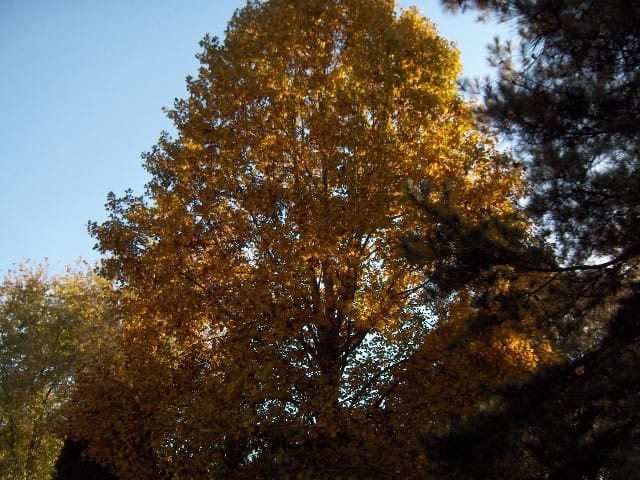Source(s): Kim D. Coder, Professor of Community Forestry, Warnell School of Forestry and Natural Resources, The University of Georgia
Have you winterized your trees yet? Fall is a time of serious change and reorganization within a tree. Many trees will not survive to grow in another Spring. You can help your trees survive and thrive.
Trees sense the changing seasons by the temperature, by a dormancy timer in the leaves, and by the amount of light they receive. The old leaves, buds, and inner bark all have a pigment that reads the seasons of the year. As the days shorten in fall, this pigment called phytochrome, tells the tree to close-down for the winter.
Getting ready for winter in an organized way is called senescence. Within a tree, a message is sent from the tissues with phytochrome which signals senescence. Senescence in trees is an ordered shutting-down of summer growth and the conservation of valuable resources. Senescence brings both the fall colors and leads to renewed spring growth.
Many of the materials a tree collected or manufactured during the growth season are withdrawn from soon-to-be dead leaves. Tree waste materials are left behind. The last bit of tree food is stockpiled in the living cells of the outer annual growth rings. Twigs, branches, and roots become the collection sites and warehouses of materials needed for another season to come.
Within the tree, biological doors and windows are being closed and locked. From the moment last Spring’s green leaved expanded and began to make food, winter dormancy has been designed into the tree system. The process of spring and summer growth reset and started a dormancy timer that now hurries the tree preparations.
The tree-filled landscapes this time of year can be mistakenly thought to be asleep. Fall and winter trees are not sleeping, but are simply still — truly counting the days until Spring.
Most of the growing points in the tree are protected inside overcoats called buds. Each growing point waits for the correct message to signal a new season of growth. Only then will it be apparent whether the tree has put aside and saved enough resources to respond to the new season of growth. Winter is a difficult time for trees. Trees must stand in the face of drying and cold winds. Food reserves must be carefully conserved for the coming needs of Spring. Water continues to be lost from the tree. Any creature needing a meal chews and nibbles on the resting buds and twigs. Trees stand alone against all circumstances that the winter season can generate.
What can you do to help your valuable trees? Little things can make your trees more effective and efficient at surviving a long winter. A few small investments now can pay-off in a large way, yielding a healthy and structurally sound tree.
The “Top 10 List” of things you can do to winterize your tree include:
- Remove or correct structural faults and deadwood that are clearly visible. Try to make small pruning cuts that minimize the exposure of the central heartwood core on branches.
- Properly prune branches that will touch the ground when loaded with rain and snow. Foliage and branches that are in contact with soil can invite undesirable pests and problems.
- Remove damaged and declining twigs, branches, and bark. Do not leave pests food and shelter for the winter.
- Remove any new sprouts that have grown at the tree base, or along stems and branches. Pruning should conserve as many living branches as possible with only a few selective cuts.
- Spread a thin layer of composted organic mulch to blanket the soil. Cover an area at least as large as the branch spread. Mulch is nature’s of recycling valuable materials, but be careful of pests hitching a ride.
- Properly wrap new trees that have not developed a corky bark and could be easily damaged. Mechanical injury from the environment, including chewing and rubbing by animals, must be prevented.
- Aerate soils if they are compacted and poorly drained. It is critical not to damage tree roots in the soil. Saturated and dense soil can suffocate roots.
- Fertilize with all the essential elements, if they are in short supply within the soil. Be sure to go lightly with nitrogen, especially under large, mature trees and around newly planted trees. It is critical to use slow release nitrogen sources for fall fertilization.
- Watering may be needed where soils are cool but not frozen, and there has been little precipitation. Winter droughts need treatment with water the same as summer droughts, except it is much easier to over-water in winter.
- Trees are investments that require a small amount of care. For the sake of your tree’s quality of life and your own, take a few minutes to winterize your tree. Wonderful springs come from well-tended winters.
Center Publication Number: 222
- Growing Grass in Shady Locations - September 24, 2013
- Drought Damages Stately Trees - September 23, 2013
- Protect Landscape Trees from Drought Injury - September 23, 2013
